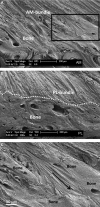A multi-scale structural study of the porcine anterior cruciate ligament tibial enthesis
- PMID: 24697495
- PMCID: PMC4025890
- DOI: 10.1111/joa.12174
A multi-scale structural study of the porcine anterior cruciate ligament tibial enthesis
Abstract
Like the human anterior cruciate ligament (ACL), the porcine ACL also has a double bundle structure and several biomechanical studies using this model have been carried out to show the differential effect of these two bundles on macro-level knee joint function. It is hypothesised that if the different bundles of the porcine ACL are mechanically distinct in function, then a multi-scale anatomical characterisation of their individual enthesis will also reveal significant differences in structure between the bundles. Twenty-two porcine knee joints were cleared of their musculature to expose the intact ACL following which ligament-bone samples were obtained. The samples were fixed in formalin followed by decalcification with formic acid. Thin sections containing the ligament insertion into the tibia were then obtained by cryosectioning and analysed using differential interference contrast (DIC) optical microscopy and scanning electron microscopy (SEM). At the micro-level, the anteromedial (AM) bundle insertion at the tibia displayed a significant deep-rooted interdigitation into bone, while for the posterolateral (PL) bundle the fibre insertions were less distributed and more focal. Three sub-types of enthesis were identified in the ACL and related to (i) bundle type, (ii) positional aspect within the insertion, and (iii) specific bundle function. At the nano-level the fibrils of the AM bundle were significantly larger than those in the PL bundle. The modes by which the AM and PL fibrils merged with the bone matrix fibrils were significantly different. A biomechanical interpretation of the data suggests that the porcine ACL enthesis is a specialized, functionally graded structural continuum, adapted at the micro-to-nano scales to serve joint function at the macro level.
Keywords: anterior cruciate ligament; enthesis; functional adaptation; macro-, micro-, and nano-level structure.
© 2014 Anatomical Society.
Figures












Similar articles
-
Dynamic Deformation Behavior of the Porcine Anterior Cruciate Ligament Enthesis Under Anterior Tibial Loading.Ann Biomed Eng. 2025 Mar;53(3):588-596. doi: 10.1007/s10439-024-03654-2. Epub 2024 Nov 27. Ann Biomed Eng. 2025. PMID: 39604621 Free PMC article.
-
Anterior cruciate ligament bundle insertions vary between ACL-rupture and non-injured knees.Knee Surg Sports Traumatol Arthrosc. 2021 Apr;29(4):1164-1172. doi: 10.1007/s00167-020-06122-1. Epub 2020 Jul 1. Knee Surg Sports Traumatol Arthrosc. 2021. PMID: 32613337
-
Microstructure Variations in the Soft-Hard Tissue Junction of the Human Anterior Cruciate Ligament.Anat Rec (Hoboken). 2017 Sep;300(9):1547-1559. doi: 10.1002/ar.23608. Epub 2017 May 5. Anat Rec (Hoboken). 2017. PMID: 28437856
-
The functions of the fibre bundles of the anterior cruciate ligament in anterior drawer, rotational laxity and the pivot shift.Knee Surg Sports Traumatol Arthrosc. 2012 Apr;20(4):613-20. doi: 10.1007/s00167-011-1864-7. Epub 2012 Jan 26. Knee Surg Sports Traumatol Arthrosc. 2012. PMID: 22278656 Review.
-
Anatomy of the anterior cruciate ligament with regard to its two bundles.Clin Orthop Relat Res. 2007 Jan;454:35-47. doi: 10.1097/BLO.0b013e31802b4a59. Clin Orthop Relat Res. 2007. PMID: 17075382 Review.
Cited by
-
Modified tibial tunnel placement for single-bundle posterior cruciate ligament reconstruction reduces the "Killer Turn" in a biomechanical model.Medicine (Baltimore). 2019 Dec;98(52):e18439. doi: 10.1097/MD.0000000000018439. Medicine (Baltimore). 2019. PMID: 31876724 Free PMC article.
-
Permanent knee sensorimotor system changes following ACL injury and surgery.Knee Surg Sports Traumatol Arthrosc. 2017 May;25(5):1461-1474. doi: 10.1007/s00167-017-4432-y. Epub 2017 Feb 2. Knee Surg Sports Traumatol Arthrosc. 2017. PMID: 28154888
-
Understanding the structural biology of osteomalacia through multiscale 3D X-ray and electron tomographic imaging: a review of X-linked hypophosphatemia, the Hyp mouse model, and imaging methods.JBMR Plus. 2024 Dec 30;9(2):ziae176. doi: 10.1093/jbmrpl/ziae176. eCollection 2025 Feb. JBMR Plus. 2024. PMID: 39896117 Free PMC article. Review.
-
Dynamic Deformation Behavior of the Porcine Anterior Cruciate Ligament Enthesis Under Anterior Tibial Loading.Ann Biomed Eng. 2025 Mar;53(3):588-596. doi: 10.1007/s10439-024-03654-2. Epub 2024 Nov 27. Ann Biomed Eng. 2025. PMID: 39604621 Free PMC article.
-
Structural and Ultrastructural Characteristics of Bone-Tendon Junction of the Calcaneal Tendon of Adult and Elderly Wistar Rats.PLoS One. 2016 Apr 14;11(4):e0153568. doi: 10.1371/journal.pone.0153568. eCollection 2016. PLoS One. 2016. PMID: 27078690 Free PMC article.
References
-
- Amis AA. The functions of the fibre bundles of the anterior cruciate ligament in anterior drawer, rotational laxity and the pivot shift. Knee Surg Sports Traumatol Arthrosc. 2012;20:613–620. - PubMed
-
- Amis AA, Dawkins GP. Functional anatomy of the anterior cruciate ligament. Fibre bundle actions related to ligament replacements and injuries. J Bone Joint Surg Br. 1991a;73:260–267. - PubMed
-
- Amis AA, Dawkins GPC. Functional anatomy of the anterior cruciate ligament. J Bone Joint Surg. 1991b;73-B:8. - PubMed
-
- Benjamin M, Kumai T, Milz S, et al. The skeletal attachment of tendons – tendon ‘entheses’. Comp Biochem Physiol A Mol Integr Physiol. 2002;133:931–945. - PubMed
Publication types
MeSH terms
LinkOut - more resources
Full Text Sources
Other Literature Sources

